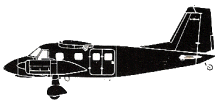Incident Overview

Description
A Dornier Do 128-2 Skyservant was destroyed in a landing accident at San Pablo’s Coaselsa Airstrip, Ecuador. One pilot was killed in the accident. The airplane departed Manta at 17:11. On board were an instructor pilot, a student pilot, a pilot observer and 70 boxes of shrimp larvae. When the aircraft reached the cruising level of 5,000 feet, power fluctuations were noticed on the right engine. The instructor pilot switched on the auxiliary fuel pump and changed the fuel mixture. The engine problems persisted. When on base leg to land on the Coaselsa airstrip, the right engine stopped and the approach was continued on one engine. The wheels touched the ground in the last 292 meters of the runway. The airplane bounced and touched down 6 meters later. The instructor pilot, considering that there was not enough distance remaining runway to stop the aircraft, decided to take control of the airplane and initiated a go around. The airplane climbed to a height of 20 m before it impacted terrain 140 m to the right of the runway centreline, 26 m past the end of the airstrip. PROBABLE CAUSE: The Accident Investigation Board determined that the probable cause of this accident was the instructor pilot’s decision to go around after landing in the last third of the runway, when the operating condition of the engine, the remaining length of runway and the aircraft weight required to stay on the ground. CONTRIBUTING FACTORS: – The decision to continue the flight when in the initial phase an engine failure required an immediate landing. – Failure to follow checklists. – The lack of adequate landing briefing by the instructor pilot. – The faulty approach for landing. – Lack of awareness of the characteristics of the runway by the pilot in command. – Overweight condition of the plane. – Lack of coordination among crewmembers. – The wrong feathering of the left engine propeller.
Primary Cause
The instructor pilot’s decision to go around after landing in the last third of the runway, despite the remaining runway length and aircraft weight, was the primary cause of the accident. This decision was driven by a perceived lack of sufficient runway distance to stop the aircraft, compounded by the engine’s operational limitations and the aircraft’s weight.The instructor pilot’s decision to go around after landing in the last third of the runway, despite the remaining runway length and aircraft weight, was the primary cause of the accident. This decision was driven by a perceived lack of sufficient runway distance to stop the aircraft, compounded by the engine’s operational limitations and the aircraft’s weight.Share on:




